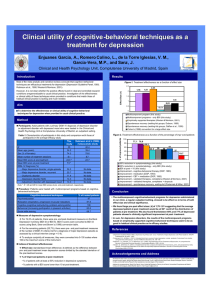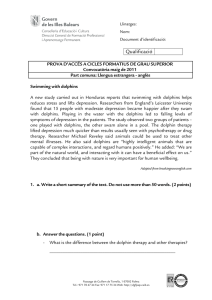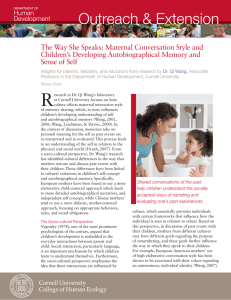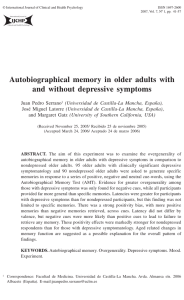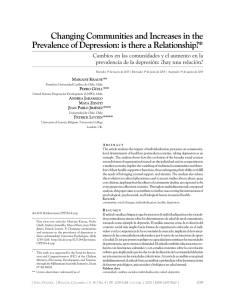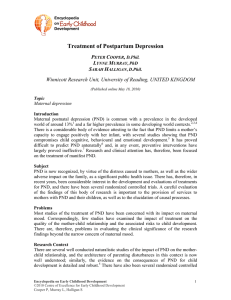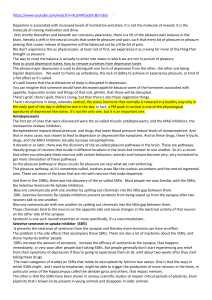Life review therapy using autobiographical retrieval
Anuncio
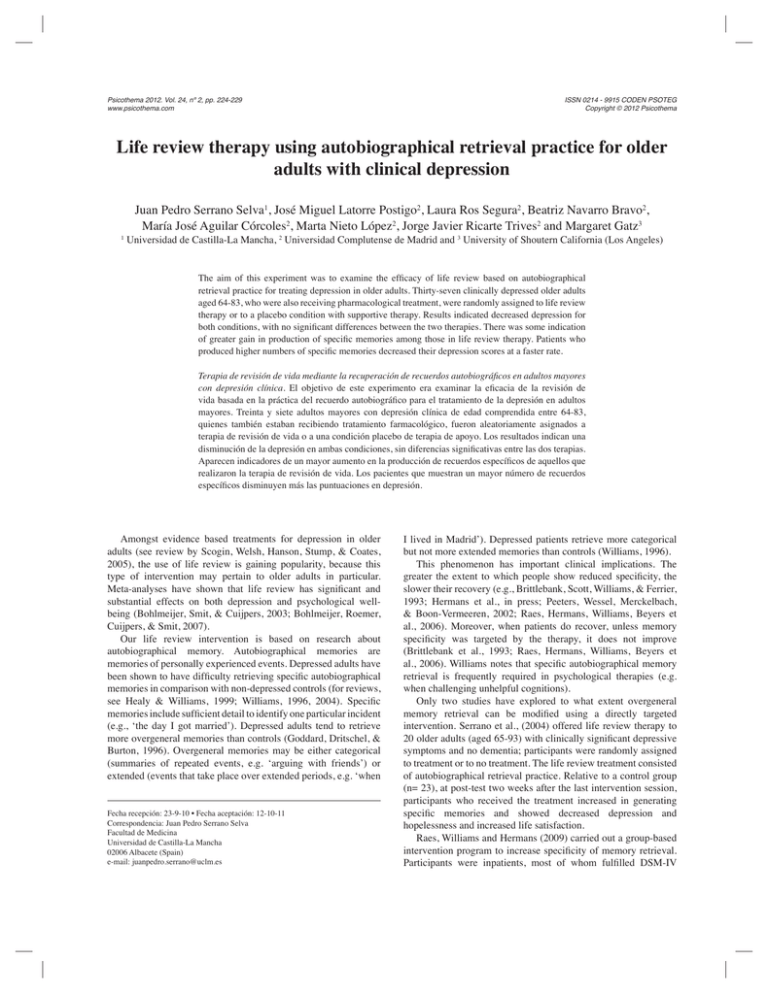
Psicothema 2012. Vol. 24, nº 2, pp. 224-229 www.psicothema.com ISSN 0214 - 9915 CODEN PSOTEG Copyright © 2012 Psicothema Life review therapy using autobiographical retrieval practice for older adults with clinical depression Juan Pedro Serrano Selva1, José Miguel Latorre Postigo2, Laura Ros Segura2, Beatriz Navarro Bravo2, María José Aguilar Córcoles2, Marta Nieto López2, Jorge Javier Ricarte Trives2 and Margaret Gatz3 1 Universidad de Castilla-La Mancha, 2 Universidad Complutense de Madrid and 3 University of Shoutern California (Los Angeles) The aim of this experiment was to examine the efficacy of life review based on autobiographical retrieval practice for treating depression in older adults. Thirty-seven clinically depressed older adults aged 64-83, who were also receiving pharmacological treatment, were randomly assigned to life review therapy or to a placebo condition with supportive therapy. Results indicated decreased depression for both conditions, with no significant differences between the two therapies. There was some indication of greater gain in production of specific memories among those in life review therapy. Patients who produced higher numbers of specific memories decreased their depression scores at a faster rate. Terapia de revisión de vida mediante la recuperación de recuerdos autobiográficos en adultos mayores con depresión clínica. El objetivo de este experimento era examinar la eficacia de la revisión de vida basada en la práctica del recuerdo autobiográfico para el tratamiento de la depresión en adultos mayores. Treinta y siete adultos mayores con depresión clínica de edad comprendida entre 64-83, quienes también estaban recibiendo tratamiento farmacológico, fueron aleatoriamente asignados a terapia de revisión de vida o a una condición placebo de terapia de apoyo. Los resultados indican una disminución de la depresión en ambas condiciones, sin diferencias significativas entre las dos terapias. Aparecen indicadores de un mayor aumento en la producción de recuerdos específicos de aquellos que realizaron la terapia de revisión de vida. Los pacientes que muestran un mayor número de recuerdos específicos disminuyen más las puntuaciones en depresión. Amongst evidence based treatments for depression in older adults (see review by Scogin, Welsh, Hanson, Stump, & Coates, 2005), the use of life review is gaining popularity, because this type of intervention may pertain to older adults in particular. Meta-analyses have shown that life review has significant and substantial effects on both depression and psychological wellbeing (Bohlmeijer, Smit, & Cuijpers, 2003; Bohlmeijer, Roemer, Cuijpers, & Smit, 2007). Our life review intervention is based on research about autobiographical memory. Autobiographical memories are memories of personally experienced events. Depressed adults have been shown to have difficulty retrieving specific autobiographical memories in comparison with non-depressed controls (for reviews, see Healy & Williams, 1999; Williams, 1996, 2004). Specific memories include sufficient detail to identify one particular incident (e.g., ‘the day I got married’). Depressed adults tend to retrieve more overgeneral memories than controls (Goddard, Dritschel, & Burton, 1996). Overgeneral memories may be either categorical (summaries of repeated events, e.g. ‘arguing with friends’) or extended (events that take place over extended periods, e.g. ‘when Fecha recepción: 23-9-10 • Fecha aceptación: 12-10-11 Correspondencia: Juan Pedro Serrano Selva Facultad de Medicina Universidad de Castilla-La Mancha 02006 Albacete (Spain) e-mail: [email protected] I lived in Madrid’). Depressed patients retrieve more categorical but not more extended memories than controls (Williams, 1996). This phenomenon has important clinical implications. The greater the extent to which people show reduced specificity, the slower their recovery (e.g., Brittlebank, Scott, Williams, & Ferrier, 1993; Hermans et al., in press; Peeters, Wessel, Merckelbach, & Boon-Vermeeren, 2002; Raes, Hermans, Williams, Beyers et al., 2006). Moreover, when patients do recover, unless memory specificity was targeted by the therapy, it does not improve (Brittlebank et al., 1993; Raes, Hermans, Williams, Beyers et al., 2006). Williams notes that specific autobiographical memory retrieval is frequently required in psychological therapies (e.g. when challenging unhelpful cognitions). Only two studies have explored to what extent overgeneral memory retrieval can be modified using a directly targeted intervention. Serrano et al., (2004) offered life review therapy to 20 older adults (aged 65-93) with clinically significant depressive symptoms and no dementia; participants were randomly assigned to treatment or to no treatment. The life review treatment consisted of autobiographical retrieval practice. Relative to a control group (n= 23), at post-test two weeks after the last intervention session, participants who received the treatment increased in generating specific memories and showed decreased depression and hopelessness and increased life satisfaction. Raes, Williams and Hermans (2009) carried out a group-based intervention program to increase specificity of memory retrieval. Participants were inpatients, most of whom fulfilled DSM-IV LIFE REVIEW THERAPY USING AUTOBIOGRAPHICAL RETRIEVAL PRACTICE FOR OLDER ADULTS WITH CLINICAL DEPRESSION criteria for major depression. Following four one-hour weekly sessions including exercises using negative and positive cues, participants’ retrieval style became significantly more specific. Based on theory and research about the effects of depression on autobiographical memory, we conducted a randomized trial to test the effects of life review therapy in older adults with major depression. We have previously found that life review therapy led to improvement on depressive symptoms among those randomly assigned to treatment compared to those randomized to no treatment (Serrano, Latorre, Gatz, & Montañés, 2004). In the present study, we compare life review therapy to a supportive intervention, extending the prior work in three ways: all participants met criteria for major depression; a placebo control group equated for contact; and two follow-up assessments were added. Also in comparison with the prior study, all participants were receiving pharmacological treatment for depression at the health care centre where the study took place. The aim and the approach that we took to life review were to provide practice for participants in producing specific autobiographical memories. We predicted that older adults who received autobiographical retrieval practice would improve their mood state, as reflected in decreased symptoms, decreased hopelessness, and increased life satisfaction. Method Participants and design Seventy-nine older adults were recruited to participate in a study to receive therapy; participants were derived from a database of outpatients who received treatment for depression at six health care centres (Albacete). Criteria for inclusion in the study were as follows: major depression as determined by Mini International Neuropsychiatric Interview (MINI; Bobes, 1998); more than 65 years old; no evidence of dementia (as determined by a score of 24 or higher on the Mini-Mental State Examination [Miniexamen cognoscitivo, MEC; Lobo, Ezquerra, Gómez Burgada, Sala, & Seva-Díaz, 1979]); receiving pharmacological treatment for depression; not currently receiving psychotherapy. After verbal consent was given, two psychologist assistants screened all volunteers. Within this group, 34 did not fulfil one of the inclusion criteria and 8 refused to participate in the study. The remaining 37 participants were randomly assigned to life review therapy (n= 18) or to the placebo control group (n= 19). Figure 1 shows the number who provided data at each time of measurement and reasons for drop out. When those who completed all times of measurement were compared to those who dropped out, the dropouts were significantly older (by an average of 3.7 years) compared to completers, t(35)= -2.04, p= .049. There were no other significant differences between dropouts and completers. The final sample included 37 older adults ranging in age from 64 to 83 years (M= 73.9 years); 31 were women and 6 were men. The educational levels were unable to read and write (13.5%), able to read and write (56.8%), completed elementary school (24.3%), completed secondary school (5.4%). The treatment and placebo groups did not differ significantly on any demographic variable or on their mental status scores. The placebo group was more depressed at pretest than the treatment group, on both number of symptoms reported on the MINI and Geriatric Depression Scale scores, t(35)= 2.46, p<.05, t(35)= 2.63, p<.05, respectively. The two groups did not differ at pretest on any other outcome measure. 225 Instruments MINI (Mini International Neuropsychiatric Interview). The Mini-International Neuropsychiatric Interview (MINI) is a brief structured diagnostic interview for DSM-IV and ICD-10 psychiatric disorders. The M.I.N.I. was designed as a brief structured interview for the major Axis I psychiatric disorders in DSM-IV and ICD-10. Validation and reliability studies have been done comparing the M.I.N.I. to the SCID-P and the CIDI. The results of these studies show that the M.I.N.I. has acceptably high validation and reliability scores, but can be administered in a much shorter period of time (mean 18.7 ± 11.6 min., median 15 min.) We used Spanish version MINI for depression (Ferrando et al., 1998). Geriatric Depression Scale. The GDS (Yesavage et al., 1983) comprises 30 questions with a dichotomous yes/no response scored to indicate the presence of depressive symptoms. The GDS was found to have a 92% sensitivity and a 89% specificity when evaluated against diagnostic criteria. We used Spanish version, where the validation of the 30 question version obtained sensitivity 0.87 and specificity 0.63. Scores of 0 - 9 are considered normal, 10 - 19 indicate mild depression and 20 - 30 indicate severe depression, with the most effective Spanish GDS cut-point (9/10). The internal consistency of the GDS, measured by means of the Cronbach alpha coefficient, was .82. We used the Spanish version (Fernández et al., 2002). Beck Hopelessness Scale. The BHS (Beck, Weissman, Lester, & Trexler, 1974) reflects an individual’s negative expectancies of the probability of attaining important goals. Twenty items representing the types of pessimistic statements made by psychiatric patients are answered true or false, and the scale is scored for pessimism, with a score of 20 reflecting the highest degree of pessimism. The authors of this article translated the BHS into Spanish. In the present sample, Cronbach’s alpha was .76. Life Satisfaction Index. Life satisfaction was measured with the 18-item Life Satisfaction Index A (LSIA; Adams, 1969). This method assigns 2 points for positive answers, 0 for negative answers, and 1 for “don’t know” answers, providing a range of 0 to 36, with the highest scores indicating the greatest satisfaction. The scale was translated into Spanish by Stock, Okun, and Gómez (1994). In the present sample, Cronbach’s alpha was .64. Quality of Life in Depression Scale. The QLSD is a 34-item “yes” (true) or “no” (false) items, such that scores range from 0 (good quality of life) to 34 (poor quality of life). depression-specific quality of life scale, designed to be responsive to change following psychopharmacological treatment (Gregoire, Leval, Mesters et al., 1994). We used the Spanish version had good test-retest reliability, 0.76 (rising to 0.96 when change in severity depression between administrations was controlled) and high internal consistency, the coefficient alpha were 0.94 at time 1 and 0.93 at time 2 (CerveraEnguix, Ramírez, Girala, & McKenna, 1999). Autobiographical Memory Test. The AMT (Williams & Broadbent, 1986) measures respondents’ ability to retrieve a specific memory under timed conditions in response to a cue word. For each of 10 cue-words (five positive and five negative), words were presented in a fixed, alternating order. To ensure that participants understood the instructions, we provided examples of general memory (e.g., summers in the city) and specific memory (e.g., the day I got married). Participants were then told “Try to remember a day or situation in the past when you felt [cue word])” and given 30 seconds to produce a memory. If no memory was 226 JUAN PEDRO SERRANO SELVA, JOSÉ MIGUEL LATORRE POSTIGO, LAURA ROS SEGURA, BEATRIZ NAVARRO BRAVO, MARÍA JOSÉ AGUILAR CÓRCOLES, MARTA NIETO LÓPEZ, JORGE JAVIER RICARTE TRIVES AND MARGARET GATZ recalled in 30 seconds, the interviewer repeated the question. If the participant did not produce a memory within 60 seconds, a score of missing was assigned. Each memory was rated as categorical, extended or specific. To be coded as specific, the recalled event could not last longer than a day. Because the total number of stimulus words was 10, the maximum score for any category was 10 and the sum of categorical, extended plus specific memories could not exceed 10. Additionally, each memory was rated for whether it was positive, negative, or neutral. Two psychologists served as raters and independently scored the responses of all participants; raters were blind to the hypotheses of the study, to experimental or control group, and to pretest, posttest, or follow-up. Interrater reliability for general versus specific was .87 at pretest and .85 at posttest. Disagreements between ratings were resolved with the principal author. Procedure Six healthcare centers were visited, informed of the study objectives, and invited to collaborate in the study. Across the six centers, a total of 20 primary care physicians agreed to participate. The physicians called inpatients who were receiving Asseses for eligibility (n= 79) Excluded (42) Ineligibility determined at screening with MEC (13) Did not fulfill DSM-IV criteria for a MDD with MINI (21) Refused to participate (8) Randomized (n= 37) Allocated to treatment (18) Allocated to placebo (19) Lost to follow-up (5) – Did not return follow-up data (n= 3) – Unexplained dropout (n= 2) 13 completed post-test Lost to follow-up (6) – Did not return follow-up data (n= 4) – Unexplained dropout (n= 2) 13 completed post-test Lost to follow-up (2) – Did not return follow-up data (n= 1) – Unexplained dropout (n= 1) Returned after missing post-test (n= 1) 12 completed 6-weeks follow-up Lost to follow-up (1) – Did not return follow-up data (n= 0) – Unexplained dropout (n= 1) Returned after missing post-test (n= 2) 14 completed 6-weeks follow-up Lost to follow-up (3) – Did not return follow-up data (n= 2) – Unexplained dropout (n= 1) 9 completed 6-months follow-up Lost to follow-up (6) – Did not return follow-up data (n= 2) – Unexplained dropout (n= 4) 8 completed 6-months follow-up Figure 1. Flow diagram of participant progress through the phases of this randomized trial (Moher et al., 2001) LIFE REVIEW THERAPY USING AUTOBIOGRAPHICAL RETRIEVAL PRACTICE FOR OLDER ADULTS WITH CLINICAL DEPRESSION pharmacological treatment for depression and were more than 65 years old, and invited them to receive a screening about their mood state in their health center with a psychologist. If the patient agreed, one of two researchers carried out the first appointment to evaluate eligibility for the study. Following written informed consent, they received an explanation of the study and a pre-test questionnaire and were randomized to condition. Measures were administered two psychologists blind to the purpose of the study. There were 4 waves data collection: at baseline prior to randomization, just after the end of 4 weeks intervention, 6 weeks later intervention (first follow-up) and 6 months after the end of intervention (second follow-up). In the second week, participants completed the autobiographical memory pretest. During the third to sixth weeks, the life review therapy was carried out with the experimental group, and the placebo control group were seen by a psychologist for one hour each week for supportive therapy during which they talked about their present concerns. Autobiographical memory posttesting for both groups took place the seventh week, and the eighth and final week concluded with the postest mood measures administered by the same two psychologist blind to the design of the study. Intervention Protocol. The life review therapy consisted of autobiographical retrieval practice that entailed focusing on a particular life period each week—childhood, adolescence, adulthood, and summary. This intervention was carried out by two psychologists trained specifically in life review therapy. For each period, 14 questions were prepared (based on Haight & Webster, 1995) that were designed to prompt specific positive memories. Examples of questions include, “What is the most pleasant situation that you remember from your childhood?”; “What did your mother or father do one day when you were a child that astonished you?”; “During adolescence, what moment do you remember as special because it was the first kiss you received or because you shared something special with someone with whom you were in love?”; “Tell me about a day when you were an adolescent and you did something out of the ordinary”;“Tell me a time that you remember experiencing the most pride at work”;“Did someone close to you or someone you knew recuperate from a grave illness?”; “If everything in your life were to happen exactly the same, what moment would you like to re-live?” and “What do you consider to be the most important thing that you have done in your life?” Intervention sessions were tape-recorded and later were scored by three psychologists blind to the purpose of the study to ensure that each prompting question was administered to each participant and that the participants performed the intervention. Data analyses Randomization was evaluated by comparing treatment and placebo groups at baseline on demographic variables and pretest scores on the outcome measures, using t-tests and chi-square. Selective dropout was tested by comparing those who provided complete data to those who did not, using t-tests and chi-square. The primary test of the hypothesis employed intent-to-treat design principles by using PROC MIXED in SAS 9.1 (SAS Institute, 2006) to estimate individual growth trajectories for each patient using all available scores from all times of measurement, as recommended by Singer (1998). This procedure essentially replaces raw scores with estimated trajectories for each individual, 227 and no one is dropped from the analysis due to missing data. We used full maximum likelihood estimation to fit an unconditional growth model including three latent variables: average score level centered at the last time of measurement; linear change; and quadratic change (measured as time-squared/2). The inclusion of quadratic change was due to the expectation that greater change would occur from directly before to directly after the treatment, with less change occurring during the follow-up period. In these models, level 1 represents individual change as a function of time and tests whether there is individual variability in level and slope. Level 2 models test whether there is variation in level and slope as a function of condition (treatment versus placebo). We report difference chi-square statistics indicate whether model fit is improved by adding each additional parameter. The significance of each parameter is indicated by t-tests. To evaluate the hypothesized mechanism, we used PROC MIXED to test whether those who produced more specific memories were lower on depression and decreased on depression to a greater extent compared to those who produced fewer specific memories. A secondary test of the hypothesis entailed a completers analysis conducted with repeated measures analysis of variance using PROC GLM in SAS 9.1 (SAS Institute, 2006). PROC GLM drops from the analysis all individuals with missing values at any time of measurement. Results Individual growth models. On the MINI measure of depression, there was significant linear change, X2(1)= 10.5, p= .0011, and significant quadratic change, X2(1)= 17.9, p<.0001. Across conditions, participants decreased in depression, most markedly during the period between the pre-test and post-test. Condition significantly predicted individual differences in change on depression on the MINI, X2(3)= 9.6, p= .0222. Inspection of the estimated individual score trajectories shows that the two conditions had parallel decreases in depression scores from pre-test to post-test, but that change in the treatment group then levelled off to a greater extent than change in the placebo group. By six-month follow-up, the depression scores for the two conditions were similar. Results were similar for the GDS measure of depression, where there again was significant linear change, X2(1)= 5.9, p= .0151, and significant quadratic change, X2(1)= 7.8, p= .0052. Condition did not significantly predict individual differences in change in depression on the GDS, X2(3)= 7.5, p= .0575. For LSI and for BHS, there was no significant linear or quadratic change, and there were no significant effects of condition. QLSD showed quadratic change, with an overall trend toward improvement. Condition predicted individual variation in level, X2(1)= 4.1, p<.0428, with higher scores for the placebo group than the treatment group, but condition did not predict individual differences in change. On the AMT variables, specific memories showed a significant quadratic effect, X2(1)= 5.0, p<.0253, with production of specific memories initially increasing and then showing less change. Condition did not significantly predict change. Categorical memories also showed a significant quadratic effect, X2(1)= 6.2, p<.0127, with production of categorical memories initially decreasing and then showing less change. There was no systematic change on extended memories or number of non-responses. It is important to recall that the four different AMT variables are 228 JUAN PEDRO SERRANO SELVA, JOSÉ MIGUEL LATORRE POSTIGO, LAURA ROS SEGURA, BEATRIZ NAVARRO BRAVO, MARÍA JOSÉ AGUILAR CÓRCOLES, MARTA NIETO LÓPEZ, JORGE JAVIER RICARTE TRIVES AND MARGARET GATZ linearly dependent, always summing to 5. Therefore, change on these variables is non-independent. The key hypothesized mechanism for change in depression is increase in specific memories, with lower depression related to greater specific memories. In a linear growth model, number of specific memories predicted level, but at only trend significance, t (26)= -2.03, p= .0532, and significantly predicted slope, t(63)= -2.36, p= .0216. Those who produced higher numbers of specific memories were lower on depression scores on the MINI and decreased in depression at a faster rate. Completers analysis. Mean scores for completers are shown in Table 1. The completers analysis showed a significant effect of time on MINI, GDS, and LSI: F(3.42)= 8.41, p= .0002, F(3,45)= 6.52, p= .0009, F(3,45)= 3.68, p= .019, respectively. These results suggest that, among participants who continued to provide data, depression was reduced and life satisfaction increased over time. Examination of the mean scores makes it clear that the largest change occurred from pretest to posttest for both treatment and placebo groups. There were no significant interactions, indicating that there were no differences between conditions in change over time. On the AMT variables, in the completers analysis no significant effects were observed for time or for the Condition X Time interaction. However, within the treatment group, there was an increase over time in the number of specific memories generated. This observation is supported by significant matched pair t-tests for members of the treatment group, comparing baseline scores to scores at post-test, t(8)= 2.60, p= .035; six-week follow-up, t(8)= 1.93, p= .096; and six-month follow-up, t(8)= 2.60, p= .035. The corresponding comparisons were not significant for the placebo group. Finally, we calculated change on MINI by subtracting baseline from last time of measurement for the individual and computed a zero order correlation between that difference score and the last score on specific memories. Consistent with the findings from the longitudinal growth models, the correlation was .42, df= 27, p= .0289. Thus, greater production of specific memories was related to greater improvement on depression. Discussion In the present study, we found that life review therapy produced a significant improvement in depressive symptoms on both the MINI and the GDS, but that there was not significantly greater improvement for those randomized to life review therapy versus to a placebo control condition comprised of supportive therapy. Our previous study (Serrano et al., 2004) had reported that life review therapy produced significantly greater improvement compared to no treatment. Taken together, these findings indicate that specific autobiographical retrieval practice can reduce symptoms of depression in older adult outpatients. The hypothesized mechanism for improvement in depression is increase in specific memories. There was modest evidence of greater improvement in specific memories among those who participated in the life review therapy and completed all times of measurement compared to the placebo control group. This effect was not significant in the intent-to-treat analyses. However, the longitudinal growth model showed that those who produced higher numbers of specific memories tended to be lower on depression scores on the MINI, and that they decreased in depression at a significantly faster rate. This analysis was complemented by the finding that improvement in depression scores on the MINI was positively correlated with the individual’s final score on specific memories from the Autobiographical Memory Test. Similar analyses with the GDS were not statistically significant. The chief limitation of the study is the small sample size. Despite randomization, there were baseline differences in depression scores across conditions. Nonetheless, the pattern of results encourages Table 1 Mean scores (and standard deviations) on outcome measures and autobiographical memory test for treatment and placebo groups, completers only Outcome measure Treatment (N= 9) Placebo (N= 8) Pre-test Post-test Six-week follow-up Six-month follow-up Pre-test Post-test Six-week follow-up Six-month follow-up MINI 6.0 (1.3) 03.1 (3.4) 04.1 (3.4) 03.3 (3.2) 06.7 (1.5) 04.1 (3.0) 02.4 (2.4) 03.0 (3.1) GDS 17.3 (5.2) 14.1 (9.8) 13.1 (8.8) 12.0 (8.7) 22.5 (3.2) 18.5 (7.4) 14.8 (6.0) 15.5 (8.8) LSI 16.3 (6.6) 17.2 (9.7) 18.2 (9.4) 19.6 (8.7) 10.0 (4.0) 14.1 (8.8) 17.0 (7.2) 17.4 (6.1) BHS 09.6 (4.6) 09.1 (6.1) 08.4 (6.7) 08.7 (5.7) 09.5 (2.3) 10.3 (3.7) 06.3 (5.3) 08.5 (5.5) QLSD 12.3 (6.3) 10.6 (6.6) 12.8 (9.8) 10.1 (8.7) 16.5 (7.9) 16.3 (8.4) 12.5 (8.6) 12.3 (9.2) AMT variable Treatment (N= 8) Pre-test Post-test Six-week follow-up Placebo (N= 6) Six-month follow-up Pre-test Post-test Six-week follow-up Six-month follow-up Categorical memories 2.8 (1.0) 2.0 (1.8) 1.4 (1.5) 2.1 (1.7) 2.5 (0.8) 2.2 (1.2) 1.5 (1.6) 1.3 (0.5) Extended memories 2.4 (1.9) 2.0 (1.3) 1.8 (1.4) 1.6 (0.9) 2.2 (1.3) 1.7 (1.4) 2.5 (2.3) 2.3 (2.1) Specific memories 2.4 (2.2) 4.0 (1.9) 3.9 (1.7) 4.0 (1.9) 2.5 (1.0) 3.3 (2.1) 1.7 (1.6) 2.7 (2.2) No response 2.5 (1.4) 2.0 (1.7) 3.0 (2.3) 2.3 (1.6) 2.8 (2.0) 2.8 (3.1) 4.3 (2.3) 3.7 (2.3) Abbreviations: MINI= total number of symptoms on Mini International Neuropsychiatric Interview; GDS= Geriatric Depression Scale; LSI= Life Satisfaction Index; BHS= Beck Hopelessness Scale; QLSD= Quality of Life in Depression Scale LIFE REVIEW THERAPY USING AUTOBIOGRAPHICAL RETRIEVAL PRACTICE FOR OLDER ADULTS WITH CLINICAL DEPRESSION further study of the potential of life review therapy for depressed older adults. Finally, depressed older adults have been shown to seek care most often from a primary care provider rather than from a mental health specialist (Uebelacker et al., 2006). For this reason, integrated models of care have been developed in which the physician and mental health specialist together deliver pharmacological and psychological treatments within primary care settings (Bartels et al., 2004; Bruce et al., 2004; Unützer et al., 2002). This study demonstrates the feasibility of delivering life review therapy in 229 the same primary health care centers where the patients are also receiving pharmacotherapy. Acknowledgements This study has been supported by the Regional Government of Castilla-La Mancha (Consejería de Educación y Ciencia de Castilla-La Mancha, grant PII1I09-0274-8863) and the Ministry of Science and Innovation (Ministerio de Ciencia e Innovación, grant PSI2010-20088). References Adams, D. (1969). Analysis of a life satisfaction index. Journal of Gerontology, 24, 470-474. Bartels, S.J., Coakley, E.H., Zubritzky, C.,Ware, J.H., Miles, K.M., et al. (2004). Improving access to geriatric mental health services: A randomized trial comparing treatment engagement with integrated versus enhanced referral care for depression, anxiety, and at-risk alcohol use. American Journal of Psychiatry, 161, 1455-1462. Beck, A.T., Weissman, A., Lester, D., & Trexler, L. (1974). The measurement of pessimism: The hopelessness scale. Journal of Consulting and Clinical Psychology, 42, 861-865. Bobes, J. (1998). A Spanish validation study of the mini international neuropsychiatric interview. European Psychiatry, 13(4), 198-199. Bohlmeijer, E., Smith, F., & Cuijpers, P. (2003). Effects of reminiscence and life review on later-life depression: A meta-analysis. International Journal of Geriatric Psychiatry, 18, 1088-1094. Bohlmeijer, E.T., Roemer, M., Smit, F., & Cuijpers, P. (2007). The effects of life-review on life-satisfaction and well-being. Aging & Mental Health, 11, 291-300. Brittlebank, A.D., Scott, J., Williams, J.M.G., & Ferrier, I.N. (1993). Autobiographical memory in depression: State or trait marker? British Journal of Psychiatry, 162, 118-121. Bruce, M.L., Ten Have, T.R., Reynolds, C.F. III, Katz, I.R., Schulberg, H.C., et al. (2004). Reducing suicidal ideation and depressive symptoms in depressed older primary care patients: A randomized controlled trial. JAMA, 291, 1081-1091. Cervera-Enguix, S., Ramírez, N., Girala, N., & McKenna, S.P. (1999). The development and validation of a Spanish version of the quality of life in depression scale (QLDS). European Psychiatry, 14, 392-399. Fernández-San Martín, M.I., Andrade-Rosa, C., Molina, J.D., Muñoz, P.E., Carretero, B., Rodríguez, M., & Silva, A. (2002). Validation of the Spanish version of the geriatric depression scale (GDS) in primary care. International Journal Geriatrics Psychiatry, 17(3), 279-287. Ferrando, L.F-AL, Soto, M., Bobes, J., Soto, O., Franco, L., & Gubert, J. (1998). Mini International Neuropsychiatric Interview. Versión en español 5.0.0. DSM-IV. Instituto IAP, Madrid. Goddard, L., Dritschel, B., & Burton, A. (1996). Role of autobiographical memory in social problem solving and depression. Journal of Abnormal Psychology, 105, 609-616. Gregoire, J., Leval, N., Mesters, P., et al. (1994). Validation of the quality in depression scale in a population of adult depressive patients aged 60 and above. Quality of Life Research, 3, 13-19. Haight, B.K., & Webster, J.D. (Eds.) (1995). The art and science of reminiscing: Theory, research methods, and applications. Bristol, PA: Taylor & Francis. Healy, H., & Williams, J.M.G. (1999). Autobiographical memory. En T. Dalgleish & M.J. Power (Eds.), Handbook of cognition and emotion (pp. 229-242). Chichester, England: John Wiley & Sons. Hermans, D., Vandromme, H., Debeer, E., Raes, F., Demyttenaere, K., Brunfaut, E., et al. (in press). Overgeneral autobiographical memory predicts diagnostic status in depression. Behaviour Research and Therapy. Lobo, A., Ezquerra, J., Gómez Burgada, F., Sala, J.M., & Seva-Díaz, A. (1979). El miniexamen cognoscitivo (Un “test” sencillo, práctico, para detectar alteraciones intelectuales en pacientes médicos) [The MiniMental Exam (A simple “test” for practical detection of intellectual alterations in medical patients)]. Actas Luso Españolas de Neurología, Psiquiatría y Ciencia, 3, 189-202. Peeters, F., Wessel, I., Merckelbach, H., & Boon-Vermeeren, M. (2002). Autobiographical memory specificity and the course of major depressive disorder. Comprehensive Psychiatry, 43, 344-350. Raes, F., Hermans, D.,Williams, J.M.G., Beyers, W., Brunfaut, E., & Eelen, P. (2006). Reduced autobiographical memory specificity and rumination in predicting the course of depression. Journal of Abnormal Psychology, 115, 699-704. Raes, F., Williams, J.M.G., & Hermans, D. (2009). Reducing cognitive vulnerability to depression: A preliminary investigation of Memory Specificity Training (MEST) in inpatients with depressive symptomatology. Journal of Behavior Therapy and Experimental Psychiatry, 40, 24-38. SAS Institute, Inc. (2006). SAS online documentation for Windows (Version Release 9.1). Cary, NC: Author. Scogin, F., Welsh, D., Hanson, A., Stump, J., & Coates, A. (2005). Evidence-based psychotherapies for depression in older adults. Clinical Psychology: Science and Practice, 12, 222-237. Serrano, J.P., Latorre, J.M., Gatz, M., & Montanes, J. (2004). Life review therapy using autobiographical retrieval practice for older adults with depressive symptomatology. Psychology and Aging, 19, 272-277. Singer, J.D. (1998). Using SAS PROC MIXED to fit multilevel models, hierarchical models, and individual growth models. Journal of Educational and Behavioral Statistics, 24(4), 323-355. Stock, W.A., Okun, M.A., & Gómez, J. (1994). Subjective well-being measures: Reliability and validity among Spanish elders. International Journal of Aging and Human Development, 38, 221-235. Uebelacker, L.A.,Wang, P.S., Berglund, P., & Kessler, R.C. (2006). Clinical differences among patients treated for mental health problems in general medical and specialty mental health settings in the National Comorbidity Survey Replication. General Hospital Psychiatry, 28, 387-395. Unützer, J., Katon, W., Callahan, C.M., Williams, J.W. Jr., Hunkeler, E., et al. (2002). Collaborative care management of late-life depression in the primary care setting: A randomized controlled trial. JAMA, 288, 28362845. Williams, J.M.G. (1996). Depression and the specificity of autobiographical memory. In D.C. Rubin (Ed.), Remembering our past: Studies in autobiographical memory (pp. 244-267). Cambridge, England: Cambridge University Press. Williams, J.M.G. (2004). Experimental cognitive psychology and clinical practice: Autobiographical memory as a paradigm case. In J. Yiend (Ed.), Cognition, emotion and psychopathology (pp. 251-269). Cambridge, England: Cambridge University Press. Williams, J.M.G., & Broadbent, K. (1986). Autobiographical memory in attempted suicide patients. Journal of Abnormal Psychology, 95, 144-149. Yesavage, J.A., Brink, T.L., Rose, T.L., Lum, O., Huang, V., Adey, M.B., & Leirer, V.O. (1983). Development and validation of a geriatric depression screening scale: A preliminary report. Journal of Psychiatric Research, 17, 37-49.
